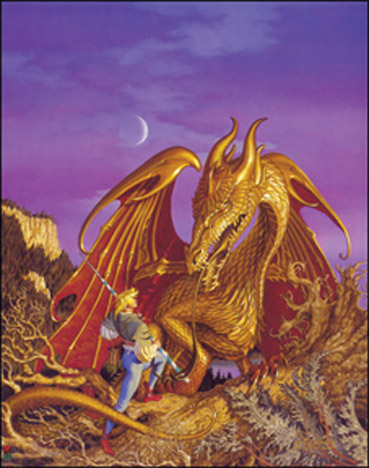
| The great epics in
Persian literature abound with tales of heroes fighting gold
guarding dragons while a famous European legend shows that
Saint George, the Patron Saint of England, supposedly killed
a dragon to save the daughter of a Libyan King.
|
By Amal HEWAVISSENTI
 For
thousands of years, the fire-breathing dragons lived in people's
imaginations. Most interestingly, dragons were thought to be an
unearthly combination of features of many different animals such as the
scaly body and elongated toil of a typical reptile, claws of lions,
wings similar to those of a bat, and hideous jaws like a crocodile's. In
legendary accounts, when dragons were not kidnapping princesses or
terrorizing villages, these solitary monsters were believed to be living
in caves where they guarded great treasures. For
thousands of years, the fire-breathing dragons lived in people's
imaginations. Most interestingly, dragons were thought to be an
unearthly combination of features of many different animals such as the
scaly body and elongated toil of a typical reptile, claws of lions,
wings similar to those of a bat, and hideous jaws like a crocodile's. In
legendary accounts, when dragons were not kidnapping princesses or
terrorizing villages, these solitary monsters were believed to be living
in caves where they guarded great treasures.
Dragons around the world are portrayed in the myths and legends of
many cultures and ancient depictions of dragon like creatures have been
found on Ishtar Gate in Babylon, the pre-historic writings in Egypt, and
specially in Chinese paintings. In conventional Greek mythology, the
famous "Chimera" was a fire breathing dragon dwelling in a cave with a
goat's body, a lion's head, and a serpent's tail.
It is believed that Chinese dragons had long, twisting reptile's body
and short, clawed feet, but they are also typified by turned up snouts,
whiskers, antlers, and hairy ears. Strangely enough these creatures were
depicted to be kind hearted monsters who symbolized rain clouds and
brought good fortune.
According to Middle East culture, dragons were thought to cause
eclipses by devouring the moon and in Persian mythology and art, dragons
had serpent and bird features which represented both good and evil. It
is strongly believed that in ancient India, men and boys hunted dragons
in the foot hills of Himalayas to gather glittering jewels that lay
concealed in the creatures's skull.
The great epics in Persian literature abound with tales of heroes
fighting gold guarding dragons while a famous European legend shows that
Saint George, the Patron Saint of England, supposedly killed a dragon to
save the daughter of a Libyan King. Numerous examples of narratives of
Knights, (including King Arthur), saints, and other heroes who destroyed
these evil monsters in their lairs, exist in the world literatures.
Origins of dragon- myths
Some scholars suggest that the idea of dragons originated and
developed out of primitive human fears of dangerous animals such as
large snakes, and birds of prey. The concept of dragons may have also
been inspired by early discoveries of fossils of animals who have gone
into extinction.
For example many fossil skulls of prehistoric animals, found in China
have horns and jaws that resemble the dragons depicted in ancient
Chinese art. In Europe, fossils of huge cave bears, surrounded by heaps
of smaller bones, may have led to weave the tales of great dragons
hiding in the caves and preying on humans. The famous dragon statue of
Austria (1590) was based on the skull of an ice age rhinoceros
discovered in Germany. When fossil hunters in America first found
fossils of large, winged dinosaurs they called them "flying dragons".
However, the monstrous image of dragons is absolutely a mixture of
horrid attributes of prehistoric animals and is purely fictitious. The
masterminds of mythology and legendary tales have depicted the surreally
monstrous picture of the dragon in such a way as to attract billions of
fans both young and old to their tales.
The readers of the stories get carried away by the powerful suspense
that this imaginary animal creates in the course of events. Though it
sounds terrifying and weird in nature, the monster captures the interest
of the reader in a mysterious way.
The figure of this monster of imagination is closely associated with
the cultural events and national identity of China where the picture of
the animal has been and being used for decorative purposes.
Even if the dragon is supposed to be a perfect product of fantasy,
people are reluctant to believe that they did not exist on earth because
of the dexterity with which the forerunners of mythical tales painted
this surreal animal. |

